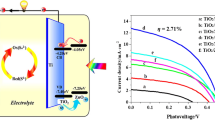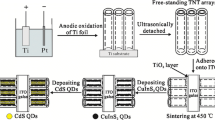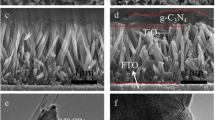Abstract
Free-standing TiO2 nanotube (NT) arrays have been prepared by a two-step anodization method. These translucent TiO2 NT arrays can be transferred to the fluorine-doped tin oxide glass substrates to form front-side illuminated TiO2 NT electrodes. The TiO2 NT electrodes were double-sensitized by CdSe/CdS quantum dots (QDs) through successive ionic layer adsorption and reaction (SILAR) process. The absorption range of the TiO2 NT electrode was extended from ~380 to 700 nm after sensitization with CdSe/CdS QDs. The SILAR cycles were investigated to find out the best combination of CdS and CdSe QDs for photovoltaic performance. The power conversion efficiency of 2.42 % was achieved by the CdSe(10)/CdS(8)/TiO2 NT solar cell. A further improved efficiency of 2.57 % was obtained with two cycles of ZnS overlayer on the CdSe(10)/CdS(8)/TiO2 NT electrode, which is 45.19 % higher than that of back-side illuminated solar cell. Furthermore, the ZnS(2)/CdSe(10)/CdS(8)/TiO2 NT solar cell possesses a higher stability than CdSe(10)/CdS(8)/TiO2 NT solar cell during the same period. The better photovoltaic performance of the ZnS(2)/CdSe(10)/CdS(8)/TiO2 NT solar cell has demonstrated the promising value to design quantum dots-sensitized solar cells with double-sensitized front-side illuminated TiO2 NT arrays strategy.









Similar content being viewed by others
References
Kamat PV (2013) Quantum dot solar cells. The next big thing in photovoltaics. J Phys Chem Lett 4:908–918. doi:10.1021/jz400052e
Ruhle S, Shalom M, Zaban A (2010) Quantum-dot-sensitized solar cells. Chem Phys Chem 11:2290–2304. doi:10.1002/cphc.201000069
Kamat PV (2012) TiO2 nanostructures recent physical chemistry advances. J Phys Chem C 116:11849–11851. doi:10.1021/jp305026h
Roy P, Berger S, Schmuki P (2011) TiO2 nanotubes: synthesis and applications. Angew Chem Int Ed Engl 50:2904–2939. doi:10.1002/anie.201001374
Sharmoukh W, Allam NK (2012) TiO2 nanotube-based dye-sensitized solar cell using new photosensitizer with enhanced open-circuit voltage and fill factor. ACS Appl Mater Interfaces 4:4413–4418. doi:10.1021/am301089t
Smith YR, Sarma B, Mohanty SK, Misra M (2012) Light-assisted anodized TiO2 nanotube arrays. ACS Appl Mater Interfaces 4:5883–5890. doi:10.1021/am301527g
Gao S, Yang J, Liu M, Yan H, Li W, Zhang J, Luo Y (2014) Enhanced photovoltaic performance of CdS quantum dots sensitized highly oriented two-end-opened TiO2 nanotubes array membrane. J Power Sources 250:174–180. doi:10.1016/j.jpowsour.2013.11.015
Albu SP, Ghicov A, Macak JM, Hahn R, Schmuki P (2007) Self-organized, free-standing TiO2 nanotube membrane for flow-through photocatalytic applications. Nano Lett 7:1286–1289. doi:10.1021/nl070264k
Kim JY, Noh JH, Zhu K, Halverson AF, Neale NR, Park S, Hong KS, Frank AJ (2011) General strategy for fabricating transparent TiO2 nanotube arrays for dye-Sensitized photoelectrodes illumination geometry and transport properties. ACS Nano 5:2647–2657. doi:10.1021/nn200440u
Chen Q, Xu D, Wu Z, Liu Z (2008) Free-standing TiO2 nanotube arrays made by anodic oxidation and ultrasonic splitting. Nanotechnology 19:365708. doi:10.1088/0957-4484/19/36/365708
Wang J, Lin Z (2008) Freestanding TiO2 nanotube arrays with ultrahigh aspect ratio via electrochemical anodization. Chem Mater 20:1257–1261. doi:10.1021/cm7028917
Guan XF, Huang SQ, Zhang QX, Shen X, Sun HC, Li DM, Luo YH, Yu RC, Meng QB (2011) Front-side illuminated CdS/CdSe quantum dots co-sensitized solar cells based on TiO2 nanotube arrays. Nanotechnology 22:465402. doi:10.1088/0957-4484/22/46/465402
Ma X, Shen Y, Wu Q, Shen T, Cao M, Gu F, Wang L (2013) Free-standing TiO2 nanotube arrays for front-side illuminated CdS quantum dots sensitized solar cells. J Inorg Organomet Polym 23:798–802. doi:10.1007/s10904-013-9846-5
Song JG, Song X, Ling T, Du XW, Qiao SZ (2012) Enhancing the conversion efficiency of semiconductor sensitized solar cells via the co-sensitization of dual-sized quantum dots. Ind Eng Chem Res 51:10074–10078. doi:10.1021/ie300109u
González-Pedro V, Xu X, Mora-Seró I, Bisquert J (2010) Modeling high-efficiency quantum dot sensitized solar cells. ACS Nano 4:5783–5790. doi:10.1021/nn101534y
Barea EM, Shalom M, Giménez S, Hod I, Mora-Seró I, Zaban A, Bisquert J (2010) Design of injection and recombination in quantum dot sensitized solar cells. J Am Chem Soc 132:6834–6839. doi:10.1021/ja101752d
Emin S, Singh SP, Han L, Satoh N, Islam A (2011) Colloidal quantum dot solar cells. Sol Energy 85:1264–1282. doi:10.1016/j.solener.2011.02.005
Sun WT, Yu Y, Pan HY, Gao XF, Chen Q, Peng LM (2008) CdS quantum dots sensitized TiO2 nanotube-array photoelectrodes. J Am Chem Soc 130:1124–1125. doi:10.1021/ja0777741
Li J, Zhao L, Wang S, Hu J, Dong B, Lu H, Wan L, Wang P (2013) Great improvement of photoelectric property from co-sensitization of TiO2 electrodes with CdS quantum dots and dye N719 in dye-sensitized solar cells. Mater Res Bull 48:2566–2570. doi:10.1016/j.materresbull.2013.03.009
Li Y, Wei L, Chen X, Zhang R, Sui X, Chen Y, Jiao J, Mei L (2013) Efficient PbS/CdS co-sensitized solar cells based on TiO2 nanorod arrays. Nanoscale Res Lett 8:67–73. doi:10.1186/1556-276X-8-67
Gao XF, Li HB, Sun WT, Chen Q, Tang FQ, Peng LM (2009) CdTe quantum dots-sensitized TiO2 nanotube array photoelectrodes. J Phys Chem C 113:7531–7535. doi:10.1021/jp810727n
Semonin OE, Luther JM, Choi S, Chen HY, Nozik AJ, Beard MC (2011) Peak external photocurrent quantum efficiency exceeding 100 % via MEG in a quantum dot solar cell. Science 334:1530–1533. doi:10.1126/science.1209845
Lee HJ, Wang M, Chen P, Gamelin DR, Zakeeruddin SM, Grätzel M, Nazeeruddin MK (2009) Efficient CdSe quantum dot-sensitized solar cells prepared by an improved successive ionic layer adsorption and reaction process. Nano Lett 9:4221–4227. doi:10.1021/nl902438d
Yu P, Zhu K, Norman AG, Ferrere S, Frank AJ, Nozik AJ (2006) Nanocrystalline TiO2 solar cells sensitized with InAs quantum dots. J Phys Chem B 110:25451–25454. doi:10.1021/jp064817b
Grätzel M (2001) Photoelectrochemical cells. Nature 414:338–344. doi:10.1038/35104607
Lee W, Kang SH, Kim JY, Kolekar GB, Sung YE, Han SH (2009) TiO2 nanotubes with a ZnO thin energy barrier for improved current efficiency of CdSe quantum-dot-sensitized solar cells. Nanotechnology 20:335706. doi:10.1088/0957-4484/20/33/335706
Lee YL, Lo YS (2009) Highly efficient quantum-dots-sensitized solar cell based on co-sensitization of CdS/CdSe. Adv Funct Mater 19:604–609. doi:10.1002/adfm.200800940
Balis N, Dracopoulos V, Bourikas K, Lianos P (2013) Quantum dot sensitized solar cells based on an optimized combination of ZnS, CdS and CdSe with CoS and CuS counter electrodes. Electrochim Acta 91:246–252. doi:10.1016/j.electacta.2013.01.004
Choi Y, Seol M, Kim W, Yong K (2014) Chemical bath deposition of stoichiometric CdSe quantum dots for efficient quantum-dot-sensitized solar cell application. J Phys Chem C 118:5664–5670. doi:10.1021/jp411221q
Feng S, Yang J, Liu M, Zhu H, Zhang J, Li G, Peng J, Liu Q (2012) CdS quantum dots sensitized TiO2 nanorod-array-film photoelectrode on FTO substrate by electrochemical atomic layer epitaxy method. Electrochim Acta 83:321–326. doi:10.1016/j.electacta.2012.07.130
Zhang J, Yang J, Liu M, Li G, Li W, Gao S, Luo Y (2013) Fabrication of CdTe Quantum dots sensitized TiO2 nanorod-array-film photoanodes via the route of electrochemical atomic layer deposition. J Electrochem Soc 161:D55–D58. doi:10.1149/2.038401jes
Chen Q, Xu D (2009) Large-scale, noncurling, and free-standing crystallized TiO2 nanotube arrays for dye-sensitized solar cells. J Phys Chem C 113:6310–6314. doi:10.1021/jp900336e
Jung SW, Kim JH, Kim H, Choi CJ, Ahn KS (2012) ZnS overlayer on in situ chemical bath deposited CdS quantum dot-assembled TiO2 films for quantum dot-sensitized solar cells. Curr Appl Phys 12:1459–1464. doi:10.1016/j.cap.2012.04.012
Gooding AK, Gómez DE, Mulvaney P (2008) The effects of electron and hole injection on the photoluminescence of CdSe/CdS/ZnS nanocrystal monolayers. ACS Nano 2:669–676. doi:10.1021/nn7003469
Shen Q, Kobayashi J, Diguna LJ, Toyoda T (2008) Effect of ZnS coating on the photovoltaic properties of CdSe quantum dot-sensitized solar cells. J Appl Phys 103:084304. doi:10.1063/1.2903059
Hsu SH, Hung SF, Chien SH (2013) CdS sensitized vertically aligned single crystal TiO2 nanorods on transparent conducting glass with improved solar cell efficiency and stability using ZnS passivation layer. J Power Sources 233:236–243. doi:10.1016/j.jpowsour.2013.01.089
Tubtimtae A, Lee MW (2012) Effects of passivation treatment on performance of CdS/CdSe quantum-dot co-sensitized solar cells. Thin Solid Films 526:225–230. doi:10.1016/j.tsf.2012.11.031
Kalanur SS, Chae SY, Joo OS (2013) Transparent Cu1.8S and CuS thin films on FTO as efficient counter electrode for quantum dot solar cells. Electrochim Acta 103:91–95. doi:10.1016/j.electacta.2013.04.041
Cheng S, Fu W, Yang H, Zhang L, Ma J, Zhao H, Sun M, Yang L (2012) Photoelectrochemical performance of multiple semiconductors (CdS, CdSe, ZnS) cosensitized TiO2 photoelectrodes. J Phys Chem C 116:2615–2621. doi:10.1021/jp209258r
Kim H, Jeong H, An TK, Park CE, Yong K (2013) Hybrid-type quantum-dot cosensitized ZnO nanowire solar cell with enhanced visible-light harvesting. ACS Appl Mater Interfaces 5:268–275. doi:10.1021/am301960h
Acknowledgements
The authors gratefully acknowledge the support for this work from the Key project of Tianjin Sci-Tech Support Program (No. 08ZCKFH01400).
Author information
Authors and Affiliations
Corresponding author
Electronic supplementary material
Below is the link to the electronic supplementary material.
Rights and permissions
About this article
Cite this article
Li, Z., Yu, L., Liu, Y. et al. Enhanced photovoltaic performance of solar cell based on front-side illuminated CdSe/CdS double-sensitized TiO2 nanotube arrays electrode. J Mater Sci 49, 6392–6403 (2014). https://doi.org/10.1007/s10853-014-8366-1
Received:
Accepted:
Published:
Issue Date:
DOI: https://doi.org/10.1007/s10853-014-8366-1




